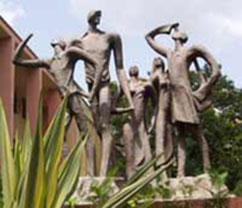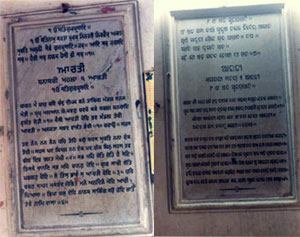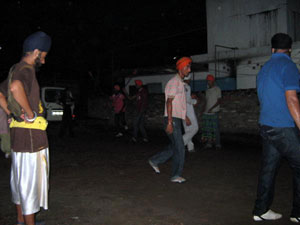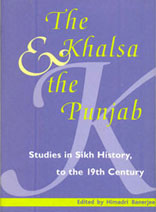* Read the Introduction to this Feature
I I joined the position in November 2002 as its third incumbent. My entry to studying the Sikhs has nothing to do with the present position in the university. My association with the discipline goes back to early 1980s. Contemporary political developments in Punjab that had resulted in the ‘otherization’ of Sikhs as a community evoked my interest in the domain of Sikh Studies. Like many Indians, I had often questioned myself: why a section of Sikhs who had earlier witnessed the ravages of 1947, were ready to go ‘from one partition to another’. But Indian media-perception made matters worse. It deliberately diverted attention by its frequent use of words like Sikhs and secessionist as if these were synonyms. With such unfortunate experiences in the background, I had started re-reading Sikh history.
Finally, on a fine summer morning, a middle aged official from the Research and Analytical Wing of the Government of India knocked at my door. He had come to visit me as a ‘friend’ on the eve of my departure to the United States and Canada (1987.) I had to face almost an hour long question-answer session. Finally, I was allowed to leave Kolkata after he was assured of ‘good conduct’ by my former Ph. D. supervisor of the University of Calcutta. II My first publication on the Sikh past coincided with my joining to the present position in November 2002. Its process, though, had started long before I was even formally associated with it. The volume is a collection of fifteen essays written by eminent historians of India. These were earlier published in the annual proceeding volumes of the Indian History Congress, the apex body of historians of the country. It was my privilege of selecting these essays and writing an introductory note to the volume The Khalsa and the Punjab: Studies in Sikh History in the 19th Century (New Delhi: Tulika and Indian History Congress).
Its second volume deals with two other important Indian languages, namely, Hindi and Marathi. It intends to incorporate many other materials communicating profiles of the Sikh past from other parts of India. A significant amount of these sources has already been collected from some of the libraries of Mumbai, Pune and Banaras. On the basis of these materials, I planned two brief essays, one devoted to each of these languages. One of these outlining the Marathi perceptions of Sikhs and Sikhism is included in the forthcoming issue of the Journal of Sikh Studies, to be published by the Guru Nanak Studies Department, Guru Nanak Dev University (Amritsar) in February 2010. The second one is already available in print (January 2010). I require one more year to complete the work on the volume. The delay is partly due to the scattered nature of the sources available in different places from Mumbai to Banaras. Their physical distance from Kolkata is another difficulty in locating them. I look forward to my years of retirement from the university (November 2010) when I intend to resume my incomplete task with some local support in Maharashtra, Bihar and Uttar Pradesh. III While holding the Guru Nanak Professorship at Jadavpur University, I have the privilege of coming in touch with the wider scholarship on the Sikh past scattered across the globe. The development of different Sikh settlements in the Diaspora has added some important perspectives to studying the Sikhs. It has not only encouraged historians of Sikhs to talk in terms of the Sikhs at Large (2008) but also refer to ‘Cross-Cultural Debates’ (2009) extending across continents. Their dialogue with the scholars from Punjab, reviewing different strands of the Sikh past, has widened the frontiers of Sikh Studies. It has possibly belied the apprehension of the late 1970s that Sikhism would be reduced to a ‘Forgotten Tradition’ vis-à-vis the other religious experiences of the world. On the contrary, the recent invigorating debate as well as the widespread enthusiasm among a section of Sikhs living in the Diaspora to know more intimately about their heritage has elevated Sikh Studies to newer prestigious positions in some of the universities on either side of the Atlantic. A small but devoted group of scholars have not only undertaken studies of the Sikh sacred text but have also introduced new tools and methodologies from other disciplines of social sciences. As a result, their works have redefined the scope of Sikh Studies. Many of its practitioners are out in search of some unknown manuscripts away from well-known centres of Sikh Studies. They frequently carry their note books and other electronic gadgets for incorporating photographs of old texts or for recording oral sources in reconstructing the Sikh past. They have tried to remind us not only of the significance of the use electronic tools but also the relevance of orality and field studies in Sikh history which were almost relegated to the background as unreliable and untrustworthy sources in the past.
IV The widening of the frontiers raised a few ripples in my mind. All these years, I have been asking myself: Why there should not be a similar mapping of minuscule Sikh settlements, lying outside Punjab but within India? Why should these scattered habitats be studied as another distinct part of Sikh Diaspora within India though it had its beginning long before the development in the West?
My travels to different parts of eastern and north-eastern India of the last quarter of a century had introduced me to some of these Sikh settlements. A few may trace their early years during the days of Sikh Gurus. Fragments of it are scattered in different genre of Janamsakhis, Bhai Gurdas’s vars, different hukamnamas of Gurus and other similar Punjabi sources. The community’s historical link with the wider Indian milieu is no less underlined in the presence of two of the five Sikh takhts and at least one hundred historical gurdwaras associated with the memory of Gurus. The Census of 2001 points out that nearly one-fifth of the total Sikh population is residing outside Punjab and there are possibly only four or five Indian districts which do not have any Sikh population. These minuscule Sikh locales have so far marginally figured in contemporary Sikh Studies. Diverse factors had brought them here. In pre-modern days, possibly pilgrimage, politics and trade played an important role. Under British rule, newer economic and military opportunities widened the scope of their journeys and encouraged them to move out of Punjab. Emigration to different south-east Asian countries and beyond made Kolkata an important port of embarkation. The Independence and the Partition of India (1947) had stimulated another few thousands’ migration while a few hundreds came to settle after their eviction from Burma in the early 1950s.
It stands distinctly different from another gurdwara which is recently built in an adjoining village following its usual forms. There was another gurdwara in Orissa (Datan Sahib at Cuttack) with one of its wall inscribed in both Oriya and Punjabi, communicating some of the lines of Sikh arati (1935).
V How many of us are aware of these Sikhs? It has been my privilege to know a few of them. It encouraged me to envision these margins of history as a mosaic located in a grand Sikh canvas. It does not communicate any meta-narrative of history owing to its dissimilar regional settings. As a practitioner of the past, I had to travel many miles beyond official record rooms. I learnt from my experience that I need to put on a strong pair of boots like an anthropologist and walk even along the community’s memory lanes. My rucksack often included many things which were infrequently cross-checked from other sources available at local levels. Reconstruction process still called for imagination based on past experiences so that many loose ends of the splintered past could have a meaningful connectivity. Finally, I am trying to communicate my understanding in the metaphor of a Sikh mosaic. It may evoke serious criticism from a section of historians. They are possibly not still ready to appreciate that some of their colleagues are contemplating the incorporation of some of the markers of the art of collage as different segments of Sikh mosaic of eastern and north-eastern would be missing their distinctiveness without it.
Its second volume deals with the Sikhs of four eastern Indian states, namely, Bihar, Jharkhand, Orissa and West Bengal. There would be five chapters, one each dedicated to Bihar, Jharkhand and Orissa while West Bengal would be represented by two Sikh groups of Kolkata. The city is proud to have Punjabi-Sikhs and the Bihari-Sikhs, the latter often contemptuously called patniyas owing to their overt link with the Patna Sahib (Bihar). Of these five chapters, two are already published in two different collections of essays. The contribution on Orissa is available in Tony Ballantyne edited volume: Textures of the Sikh Past (New Delhi: Oxford University, 2007, pp. 219-56) and the second is a part of The Calcutta Mosaic (London- New York-New Delhi: 2009, pp. 164-95). Both the volumes would be having their separate introductions and conclusions owing to the distinctiveness of regional Sikh settlements. There would possibly be some over-arching commonality among them which has also made them an integral part of the larger Sikh world. VI My long submission may give rise to an impression that instead of focusing on the activity of the Chair created in the name of Guru Nanak, I am busy narrating my small little details. But the unfortunate atmosphere surrounding the Chair has made it almost non-functional as a centre of Sikh Studies. There was just one important occasion of celebration. In 2005, the Bhai Vir Singh Sahitya Sadan requested me to organize a seminar on the occasion of Four Hundred Years of the installation of Sri Guru Granth Sahib. It kindly sanctioned a token amount for it. The seminar took place in September 2005. Two eminent professors from Punjab and two from local universities had contributed papers. Yet the proceedings of the seminar could not be published owing to paucity of fund. I am going to retire in November 2010. I look forward to a silver lining in the development of the Chair position after my retirement. If a person who is having no interest in Sikh Studies is selected there, the present position is likely to worsen. Perhaps the maxim ‘Denmark without Prince Hamlet’ would be the truest description of the situation.
|
----------------------------
About Dr. Himadri Banerjee:
| Meeting Scholar of Sikhism - Dr. Himadri Banerjee in Kolkata | |
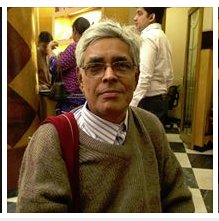 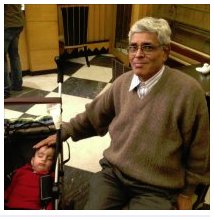 Dr. Himadri Banerjee | |
Former Chairperson of the Guru Nanak Chair in Indian History at Jadavpur University's Department of History, Dr. Banerjee has been working on Sikhs and Sikhism in eastern India for nearly four decades now. In recent years, Dr. Banerjee has been travelling in search of Sikh mosaics of eastern and north-eastern India as far as Moreh along the Indo-Myanmar border about which neither the Sikhs of Punjab nor those of the West have any idea. His book, The Other Sikhs: A View from Eastern India, is widely |
regarded as a path-breaking work on the Sikhs and their history and heritage in Assamese, Oriya and Bengali traditions. He has studied the information and records, published over a century between the First Sikh War (1845) and the Partition of India (1947), available in local languages, and has shown how the regional flavour lends its own colour to the traditions of the Sikhs. His work rediscovering the Second Diaspora beyond Punjab in India is particularly significant and relevant. .................Source |
Read further from same author http://http://www.sikhnet.com/news/hidden-plain-sight





